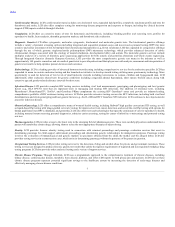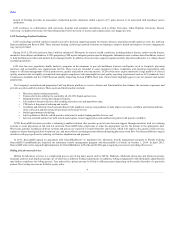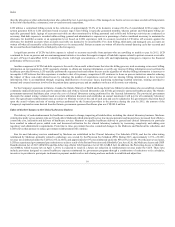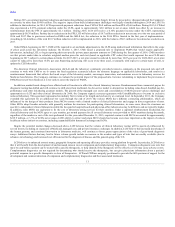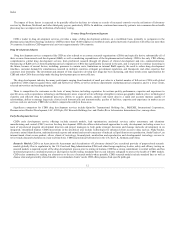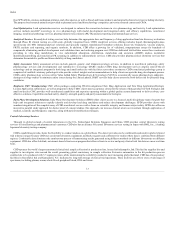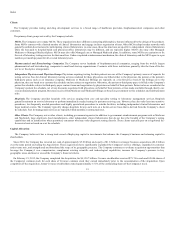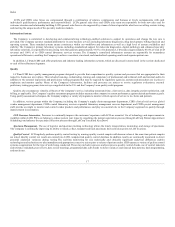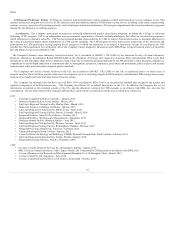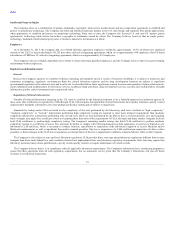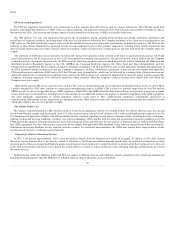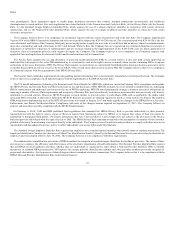LabCorp 2015 Annual Report Download - page 15
Download and view the complete annual report
Please find page 15 of the 2015 LabCorp annual report below. You can navigate through the pages in the report by either clicking on the pages listed below, or by using the keyword search tool below to find specific information within the annual report.
Index
The Company provides testing and drug development services to a broad range of healthcare providers, biopharmaceutical companies and other
customers.
The primary client groups serviced by the Company include:
The Company serves many MCOs. These organizations have different contracting philosophies, that are influenced by the design of the products.
Some MCOs contract with a limited number of clinical laboratories and engage in direct negotiation of rates. Other MCOs adopt broader networks with
generally uniform fee structures for participating clinical laboratories; in some cases, those fee structures are specific to independent clinical laboratories
while the fees paid to hospital-based and physician-office laboratories may be different, and are typically higher. MCO’s also may offer Managed
Medicare or Managed Medicaid plans. MCOs may also offer Managed care or Managed Medicaid plans. In addition, some MCOs use capitation to fix
the cost of laboratory testing services for their enrollees. Under a capitated reimbursement mechanism, the clinical laboratory and the MCO agree to a per
member, per month payment for all covered laboratory tests.
The Company serves hundreds of biopharmaceutical companies, ranging from the world’s largest
pharmaceutical and biotechnology companies to small and start-up organizations. Contracts with these institutions generally take the form of fee-for-
service or fixed-price arrangements.
Physicians requiring testing for their patients are one of the Company’s primary sources of requests for
testing services. Fees for clinical laboratory testing services rendered for these physicians are billed either to the physician, the patient or the patient’s
third-party payer, such as an insurance company, Medicare or Medicaid. Billings are typically on a fee-for-service basis. If the billings are to the
physician, they are based on a customer fee schedule and are subject to negotiation. Otherwise, the patient or third-party payer is billed at the Company's
patient fee schedule, subject to third-party payer contract terms and negotiation by physicians on behalf of their patients. Patient sales are recorded at the
Company’s patient fee schedule, net of any discounts negotiated with physicians on behalf of their patients, or fees made available through charity care
or an uninsured patient program. Revenues received from Medicare and Medicaid billings are based on government-set fee schedules and reimbursement
rules.
The Company provides hospitals with services ranging from core and specialty testing to laboratory management services. Hospitals
generally maintain an on-site laboratory to perform immediately needed testing for patients receiving care. However, they also refer less time-sensitive
procedures, less frequently needed procedures and highly specialized procedures to outside facilities, including independent clinical laboratories and
larger medical centers. The Company typically charges hospitals for any such tests on a fee-for-service basis that is derived from the Company’s client
fee schedule. Fees for management services are typically billed monthly at contractual rates.
The Company serves other clients, including government agencies (in addition to government reimbursement programs such as Medicare
and Medicaid), large employers, food manufacturers, other independent clinical laboratories that do not have the breadth of the Company’s testing
capabilities and in jurisdictions where permitted, consumers who may order diagnostic testing directly. These clients typically pay on a negotiated fee-
for-service basis or based on a set fee schedule.
The Company believes it has a strong track record of deploying capital to investments that enhance the Company's business and returning capital to
shareholders.
Since 2010, the Company has invested net cash of approximately $5.8 billion and equity of $1.8 billion in strategic business acquisitions ($2.2 billion
over the same period excluding the Acquisition). These acquisitions have significantly expanded the Company’s service offerings, expanded its customer
and revenue mix, and strengthened and broadened the scope of its geographic presence. The Company continues to evaluate acquisition opportunities that
leverage the Company’s core competencies, complement existing scientific and technological capabilities, increase the Company’s presence in key
geographic areas, and meet or exceed the Company’s financial criteria.
On February 19, 2015, the Company completed the Acquisition, for $6,150.7 billion. Covance stockholders received $75.76 in cash and 0.2686 shares of
the Company's common stock for each share of Covance common stock they owned immediately prior to the consummation of the Acquisition. Upon
completion of the Acquisition, former Covance stockholders owned approximately 15.5% of the outstanding shares of the Company's stock.
15




